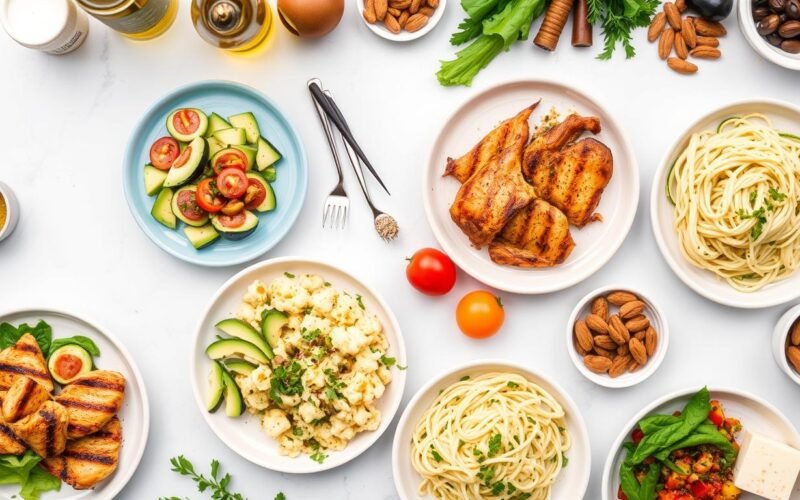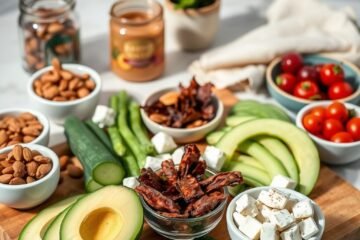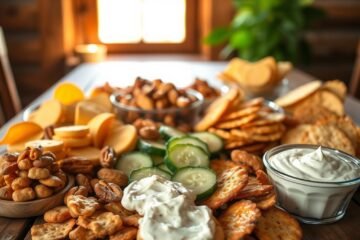Are you ready to embark on a journey towards a healthier lifestyle? The ketogenic diet has gained immense popularity for its potential to promote weight loss, enhance energy levels, and improve overall health. However, getting started can be overwhelming, especially for beginners. Fear not! Our 7-Day Keto Meal Plan is designed to simplify your journey and make meal prepping a breeze. With a focus on delicious low-carb recipes, this plan will guide you through your first week, ensuring you enjoy healthy meal prep without the stress. Let’s dive in and discover how you can kick-start your ketogenic lifestyle today!
Did you know 83% of people lose weight in the first month on a keto diet? This shows how effective the ketogenic diet can be for weight loss. Our 7-day keto meal plan is here to kickstart your low-carb journey and help you reach your health goals.
This plan includes a variety of keto recipes that are rich in healthy fats and proteins. By cutting down on carbs, your body starts burning fat for energy instead of sugar. You’ll enjoy tasty meals that fit perfectly into the keto diet’s macronutrient ratios.
Let’s take a look at some key ingredients and their nutritional values. For example, a tablespoon of avocado oil has 124 calories and 14 grams of fat, with no carbs. A 4-ounce serving of ground beef has 375 calories, 34 grams of fat, and 16 grams of protein. It’s a great choice for keto-friendly meals.
Start with the Beginner’s Keto Guide and plan your shopping with this keto pantry list.
Key Takeaways
- This 7-day keto meal plan for beginners focuses on simple prep, leftovers, and realistic weeknight meals.
- Expect repeat breakfasts, batch-cooked proteins, and plenty of non-starchy vegetables to hit macro targets.
- Getting started with keto is about limiting net carbs, increasing healthy fats, and staying hydrated.
- The beginner keto meal guide is scalable and uses common grocery items for convenience.
- Practical tips in the plan help you avoid common pitfalls like low electrolytes and monotonous meals.
Understanding the Ketogenic Diet Fundamentals
The ketogenic diet is a plan that focuses on high-fat, low-carb foods. It aims to put your body in a state called ketosis. This diet has become popular for its health benefits and weight loss.
Macronutrient Ratios
Tracking macronutrients is key in the ketogenic diet. The usual ratio is:
- Fats: 70-75% of total calories
- Protein: 15-20% of total calories
- Carbs: 5-10% of total calories
This means eating very few carbs, about 20-50 grams a day on a 2,000-calorie diet. Foods high in fat are the mainstay of this diet.
The Science of Ketosis
By cutting down on carbs, your body goes into ketosis. In this state, it uses fat for energy instead of sugar. This change can lead to weight loss. Studies show people on this diet lose about 2 pounds more than those on low-fat diets.
Health Benefits
The ketogenic diet may also help with other health issues. It could be good for type 2 diabetes, epilepsy, and heart disease. A 2020 review in Nutrition & Diabetes found it improves blood sugar and lipid levels.
“The ketogenic diet can help with weight loss and health improvements,” according to recent studies.
Even with its benefits, it’s wise to talk to a healthcare professional before starting this diet.
Keto Diet Plan Essentials
Starting a keto diet means planning your meals carefully. We’ll look at the key parts of a good keto meal plan. This includes the foods you can eat, what to avoid, and tips for meal prep.
Approved Foods and Ingredients List
Keto-friendly foods are the base of your diet. Make sure to include these foods rich in nutrients:
- Meats: Beef, pork, chicken, turkey
- Fish: Salmon, tuna, mackerel
- Eggs and dairy: Cheese, butter, heavy cream
- Nuts and seeds: Almonds, walnuts, chia seeds
- Low-carb vegetables: Spinach, broccoli, cauliflower
Foods to Avoid on Keto
To stay in ketosis, avoid foods high in carbs:
- Grains: Wheat, rice, oats
- Sugary foods: Candy, soda, fruit juices
- High-carb fruits: Bananas, apples, grapes
- Starchy vegetables: Potatoes, corn, peas
Hydration, electrolytes, and managing keto flu
Low-carb diets can lead to fluid loss. Drink at least 64 ounces (about 2 liters) of fluids daily. Add salt to meals and sip full-sodium broth when needed.
Eat potassium-rich, low-carb veggies and consider magnesium supplements for cramps or sleep issues. If you experience headaches, fatigue, dizziness, or constipation, increase fluids and electrolytes. Eat enough dietary fat and rest with light activity.
Kitchen Preparation and Grocery Shopping Tips
Good meal prep is key for keto success. Organize your kitchen, get rid of high-carb items, and stock up on keto-friendly foods. When shopping, check labels to avoid hidden carbs and sugars.
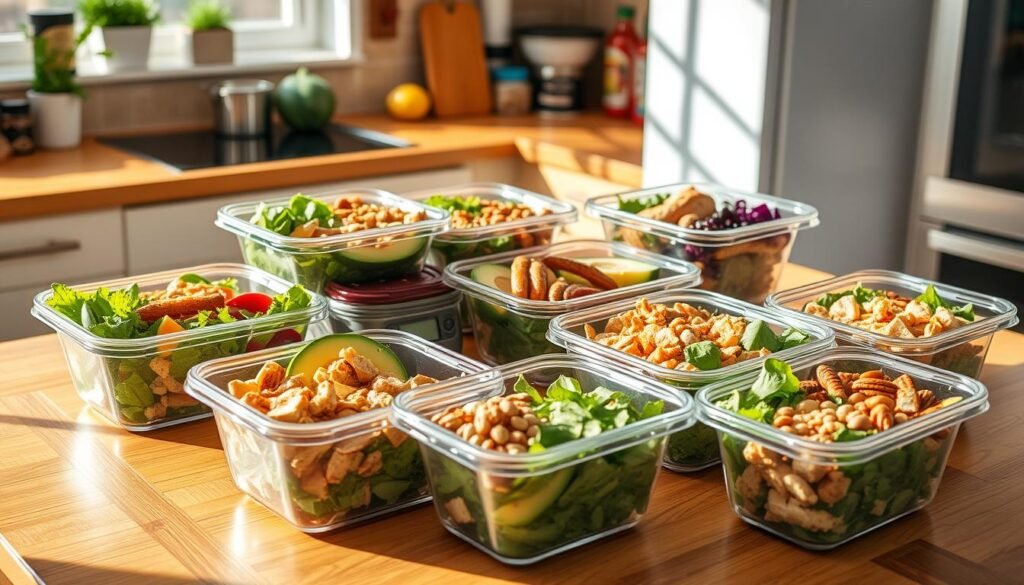
- Plan your meals for the week
- Batch cook proteins and low-carb vegetables
- Prepare grab-and-go snacks like hard-boiled eggs or cheese cubes
- Store meals in portion-controlled containers
| Meal | Protein | Fat | Low-Carb Veggies |
|---|---|---|---|
| Breakfast | Eggs | Avocado | Spinach |
| Lunch | Grilled chicken | Olive oil dressing | Mixed greens |
| Dinner | Salmon | Butter | Asparagus |
By focusing on keto-friendly foods, avoiding high-carb ingredients, and using smart meal prep, you’ll do great on your keto journey.
Day 1 to Day 7 Easy Keto Meal Ideas and Daily Menus
Down Load or Print: 7- day Keto Meal Plan- PDF
A good keto meal plan is essential for success on this diet. Our 7-day guide includes tasty keto recipes and healthy meals to help you stay on track. Let’s explore how to plan your keto week.
This meal plan is easy to follow. Meals are repeated to save time and reduce waste. It focuses on protein, veggies, and quick snacks.
Day 1
Breakfast: 2-egg spinach omelet + ½ avocado.
Lunch: Chicken salad lettuce wraps using batch grilled chicken.
Dinner: Baked salmon + zucchini noodles with pesto. Save half the salmon for Day 2 lunch.
Snack: Unsweetened Greek yogurt with chia or 10–12 almonds.
Simple swap: Tofu scramble or a chickpea-free egg salad for a vegetarian option.
Day 2
Breakfast: Chia pudding jar topped with 30–40 g berries.
Lunch: Salmon salad bowl with mixed greens, olive oil, and capers.
Dinner: Beef mince stir-fry with cabbage and coconut aminos. Brown extra beef for Day 3 breakfast.
Snack: Cheese stick or cucumber with cream cheese.
Swap: Tempeh stir-fry for a vegetarian alternative.
Day 3
Breakfast: Scrambled eggs mixed with browned beef, sautéed greens, and pumpkin seeds.
Lunch: Leftover beef stir-fry served over cauliflower rice.
Dinner: Garlic butter shrimp with zucchini noodles. Portion shrimp so you have extras for another meal.
Snack: Olives or a boiled egg.
Swap: Mushroom and halloumi skillet instead of shrimp for a vegetarian twist.
Day 4
Breakfast: Spinach and Swiss omelet topped with avocado and salsa.
Lunch: Avocado and egg salad in lettuce cups using hard-boiled eggs.
Dinner: Cajun-spiced chicken breast with cauliflower rice and sautéed Brussels sprouts or broccoli. Roast extra chicken for Day 5 lunches.
Snack: Mixed nuts or cheese slices.
Swap: Omit cheese and use avocado-based dressings to keep it dairy-free.
Day 5
Breakfast: 2 eggs fried in butter with avocado and a small serving of blackberries.
Lunch: Grilled salmon over mixed leafy greens with olive oil.
Dinner: Chicken breast with cauliflower mash and green beans. Make extra mash for Day 6.
Snack: Kale chips or celery with nut butter.
Swap: Grilled halloumi or tempeh for a vegetarian alternative.
Day 6
Breakfast: Egg muffins with cheddar and spinach.
Lunch: Tuna salad with avocado and macadamia nuts.
Dinner: Pork chops with nonstarchy vegetables like asparagus and mushrooms.
Snack: Cheese and bell pepper slices.
Swap: Replace cheese with extra nuts or avocado to stay dairy-free.
Day 7
Breakfast: Unsweetened Greek yogurt with keto-friendly granola or chia seeds.
Lunch: Bunless beef burger with guacamole and kale salad.
Dinner: Stir-fried chicken with broccoli, mushrooms, and peppers in a low-carb satay or coconut aminos sauce. Use remaining batch items to clear the fridge.
Snack: Sugar-free turkey jerky or an egg muffin.
Swap: Portobello mushroom “burger” or cauliflower steak for a vegetarian plate.
This seven-day plan offers easy keto meals and recipes for beginners. It’s perfect for weight loss. Use batch cooking and repeat meals to make your week easier.
Sample Weekly Grocery List and Macronutrient Notes
Start by checking your pantry and fridge so you buy only what you need.This lets you make a clear sample keto grocery list. It also helps with batch cooking and using leftovers for lunches.
Here are some focused shopping suggestions. Choose ready-to-eat grilled chicken or raw breasts to grill. Pick quality salmon fillets for baking. Add bone broth, sea salt, and an electrolyte supplement if you expect heavy sweating.
Use a keto diet meal planner or an app to pace your buys and avoid waste. Planning makes it easy to turn ingredients into keto-friendly recipes. It also helps with simple keto meal plans for the week.
Shopping focused on proteins and batch items
- Eggs (12)
- Grilled chicken or raw chicken breasts (1 kg)
- Salmon fillets (2)
- Ground beef (for stir-fry)
- Pork chops and shrimp (optional)
Produce, nonstarchy veggies, and pantry items
- Cauliflower rice (4 cups or 2 heads)
- Zucchini or pre-spiralized noodles (4 cups)
- Avocados (4–6)
- Mixed leafy greens (2–3 bags), spinach (1 bag)
- Bell peppers, broccoli, cabbage, cucumbers, lemons, herbs
Healthy fats, dairy, snacks, and beverages
- Olive oil, avocado oil, coconut oil
- Butter, cream cheese, full-fat Greek yogurt, assorted cheeses
- Mayonnaise without sugar, vinegars, coconut aminos, pesto or pesto ingredients
- Chia seeds, almonds, macadamia nuts, cheese sticks
- Unsweetened almond milk, coffee, tea, bone broth
Items to support electrolytes and hydration
- Bone broth cartons or bouillon cubes
- Sea salt or Himalayan salt
- Electrolyte supplements (optional)
Estimating macros per meal keeps you on track. A simple approach is 3–6 oz protein servings, 1–2 tablespoons of oil or butter, and 1/2 avocado when a recipe calls for added fat. Aim for total daily net carbs near 20–40 g depending on your goal.
Use the table below to see a compact weekly checklist and rough macro guidance per item. This makes your sample grocery list keto practical and aligned with a low-carb meal plan.
| Item | Qty for Week | Primary Use | Macro Notes (per typical portion) |
|---|---|---|---|
| Eggs | 12 | Omelets, hard-boiled snacks | 2 eggs ≈ 12g fat, 12g protein, 1–2g net carbs |
| Chicken (raw) | 1 kg | Grill for salads, bowls | 100g cooked ≈ 3g fat, 31g protein, 0g carbs |
| Salmon fillets (baked) | 2 fillets | Dinners, salad toppers | 100g cooked ≈ 13g fat, 20g protein, 0g carbs |
| Cauliflower rice | 4 cups | Side, fried rice substitute | 1 cup ≈ 3g fat (with oil), 2g protein, 3g net carbs |
| Zucchini noodles | 4 cups | Pasta substitute | 1 cup ≈ 0.5g fat, 1g protein, 3g net carbs |
| Avocados | 3–4 | Fat boost, salads | ½ avocado ≈ 15g fat, 2g protein, 2g net carbs |
| Full-fat Greek yogurt | 1 small tub | Chia pudding, snacks | 100g ≈ 10g fat, 9g protein, 4–5g net carbs |
| Chia seeds | Enough for 4 jars | Chia pudding | 1 tbsp ≈ 4.5g fat, 2g protein, 0.5–1g net carbs |
| Olive oil / Butter | As needed | Cooking, dressings | 1 tbsp olive oil ≈ 14g fat, 0g protein, 0g carbs |
| Nuts (almonds) | 1 small bag | Snack portions | 1 oz ≈ 14g fat, 6g protein, 2–3g net carbs |
Portion Control and Macro Tracking
It’s important to keep the right balance of macronutrients for ketosis. Aim for 55-60% fats, 30-35% protein, and 5-10% carbs. Use a food scale and app to track your macros accurately.
| Meal | Calories | Protein (g) | Carbs (g) | Fat (g) |
|---|---|---|---|---|
| Breakfast | 400-500 | 25-30 | 5-10 | 30-35 |
| Lunch | 500-600 | 30-35 | 10-15 | 35-40 |
| Dinner | 600-700 | 35-40 | 15-20 | 45-50 |
| Snacks | 200-300 | 10-15 | 5-10 | 15-20 |
This meal plan is for about 2,000 calories a day. Adjust portions based on your calorie needs and activity level. With careful planning and delicious keto recipes, you’ll find that low-carb meals are satisfying and nutritious.
Maximizing Success on Your Keto Journey
Starting a keto diet needs careful planning and dedication. To increase your success, use these keto diet tips and meal planning strategies. A structured 21-day program can guide you through dietary restrictions.
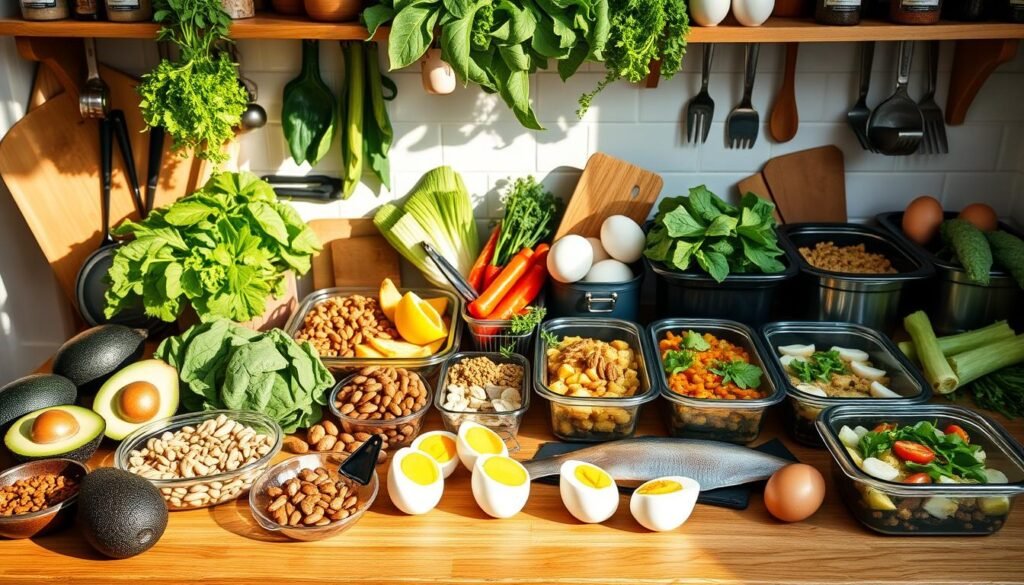
It’s important to check your ketone levels to make sure you’re in ketosis. This state helps with weight loss and improves blood sugar control and heart health. The Ultimate Keto Meal Plan makes it easy, focusing on high-fat meals for quick and lasting weight loss.
Following a good keto plan boosts your energy and mental clarity. The right mix of nutrients helps burn fat, giving you energy all day. It also cuts down on cravings and hunger, making it easier to stay on your weight loss diets.
| Benefit | Description |
|---|---|
| Weight Loss | Rapid and consistent fat loss through ketosis |
| Energy Levels | Sustained energy from well-balanced meals |
| Mental Focus | Improved cognitive function and productivity |
| Heart Health | Incorporation of heart-healthy fats |
| Blood Sugar Control | Better management of insulin resistance |
By using these strategies and the Free 21-Day Keto Transformation Program, you can get lasting results. Remember, staying consistent is the key to mastering this effective way to manage weight and improve health.
Conclusion
Starting a keto lifestyle can change your life if you want to manage your weight and get healthier. This 7-day meal plan is a great start for beginners. It helps you eat healthy by focusing on fats and low carbs.
Research shows that people on keto diets lose about 2 pounds more than those on low-fat diets in a year. The keto diet can also improve your cholesterol, hormone balance, and even protect your brain.
But, it’s important to make diet choices that you can keep up with for the long term. The keto diet works well for many, but it’s not for everyone. If you have health issues, talk to a doctor before changing your diet.
Remember, finding the right balance is key on the keto diet. Most people aim for 55-60% fat, 30-35% protein, and 5-10% carbs. This plan is a starting point. Feel free to make it your own while sticking to keto principles.
With careful planning and commitment, the ketogenic diet can be a powerful ally in your journey to better health and lasting weight management.

